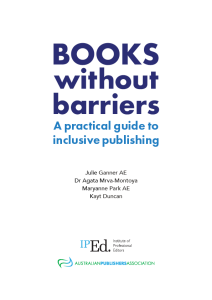Books Without Barriers: A Practical Guide to Inclusive Publishing

Books Without Barriers is a new guide to inclusive publishing that contains comprehensive, detailed advice on how to create accessible books. The guide was written by members of the Institute of Professional Editors (IPEd) and is co-published by IPEd and the Australian Publishers Association (APA), with support from the Copyright Agency Cultural Fund in Australia.
An IPEd working party was formed in late 2020 to continue the work begun by the Australian Inclusive Publishing Initiative. To support the publishing industry in its transition to inclusive publishing practices, the group decided to focus on creating a resource that would bring together, in one publication, research and advice covering the whole publishing process from start to finish.
The advice in Books Without Barriers is based on practical experience, extensive research and consultation across the publishing and disability sectors. A starting point was the practical skills and accumulated knowledge of the working party as writers, editors, and publishers. This included the experience of Sydney University Press in implementing a format-neutral workflow and producing accessible ebooks.
The IPEd group then conducted a comprehensive review of the international literature and existing guidelines related to web accessibility and accessible publishing. In collaboration with the University of Sydney, IPEd also carried out surveys of readers with print disability, alternative format providers and publishers. Finally, once the first draft of the guide was ready, IPEd consulted accessibility experts, editors, publishers, alternative format providers, audiobook producers and people with print disability to ensure the advice in the guide is accurate, comprehensive and useful. Inclusive Publishing was delighted to be part of this process.
Books Without Barriers is presented in 4 parts:
- Planning for inclusive publishing: the diverse ways in which the audience reads, developing an accessibility policy for publishers, and planning the publishing workflow.
- Developing content: writing and editing, creating accessible tables, considerations for mathematics and science, and considerations for children’s books.
- Describing images and tables: how to write image descriptions, the steps involved in drafting them, and examples of descriptions for different types of illustration.
- Producing accessible books: design, digital formats, audiobooks, and testing and reviewing for quality assurance.
Books Without Barriers builds on Inclusive Publishing in Australia: An Introductory Guide. Published by the Australian Inclusive Publishing Initiative in 2019, the introductory guide explains the business, social and legal reasons for creating accessible publications. IPEd hopes the advice provided in Books Without Barriers will further support publishers by making the process of producing accessible books easier to understand for all those involved.
You can download the guide as a PDF or accessible Word document from the IPEd or APA website. An accessible PDF, EPUB and a digital braille transcript will also be available soon.
This news piece was written by Dr Agata Mrva-Montoya, University of Sydney and co-author of these excellent guidelines.


